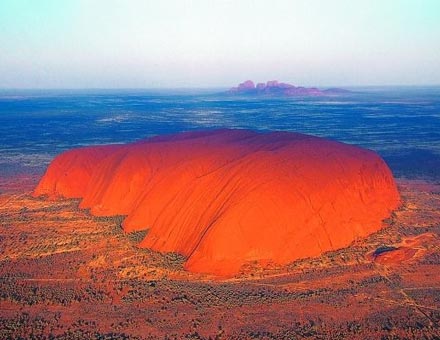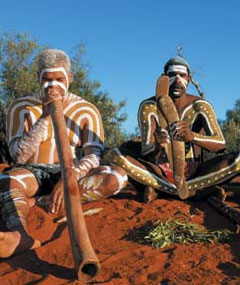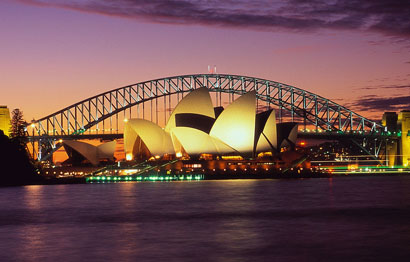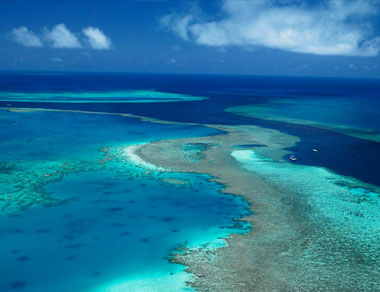Australia
Country statistics

Land area: 2,941,283 sq miles (7,617,931 sq km)
Total area: 2,967,909 sq miles (7,686,850 sq km)
Population (2011 est.): 21,766,711 (growth rate: 1.148%); birth rate: 12.33/1000; infant mortality rate: 4.61/1000; life expectancy: 81.81
Capital City: Canberra
Monetary unit: Australian dollar
Languages: English, native languages
Ethnicity/race: Caucasian 92%, Asian 7%, aboriginal (353,000) and other 1%
Religions: Anglican 26.1%, Roman Catholic 26%, other Christian 24.3%
Country introduction

Australia is an island nation that makes up the Australian continent as well as the island of Tasmania and some other small islands. Neighbouring countries include Indonesia, East Timor and Papua New Guinea to the north, the Solomon Islands, Vanuatu and the French dependency of New Caledonia to the east, and New Zealand to the south-east.
Australia has a very dramatic landscape and is famous for its 'outback', the remote lands of the interior. The desert outback covers most of the interior. It is too hot, dry and barren to support many people.
Eastern Australia has large areas of grasslands, used primarily for sheep and cattle ranches. Australia also has some mountainous areas and plateaus scattered throughout the country. The Blue Mountains, on the south-eastern end of Australia, get their name from the blue haze caused by oil droplets given off from the eucalyptus trees. One of the outback's Australian attractions, is the Ayers Rock, which was also known as Uluru. Uluru was named Ayers Rock by a European explorer William Christie Gosse. The rock shifts it's colors as the day progresses.
Austraila also have some of the most exotic coral beach islands. The Great Barrier Reef stretches along the coast of Queensland. It is the world's largest coral reef and is over 2,000 km (1,242 miles) long overall.
The culture

Australia is very much a multi-cultural nation, having enjoyed waves of immigration starting with the Australian Aboriginals 40,000 years ago, followed by the English 200 years ago. Since World War II, Australia has received millions of migrants, with the population roughly tripling over a period of fifty years. However, although Australia is similar in size to the continental USA, its population is still only around 18 million and is heavily concentrated in the major coastal cities.
Much of the Australian life-style revolves around the outdoors and sport. Australians like to relax actively by bush-walking, skiing, surfing, sailing, swimming, or any other activity that takes them into the sun and open air. Whilst keen watchers of a wide variety of sports, Australians also like to be active participants, and continue to take part in organized and social sport throughout their lives.
Attractions & landmarks

Australia has natural attractions, animals, plants and landscapes not found anywhere else in the world. Visitors will find sub-tropical islands to lounge on, mountains to ski, desert areas, savannah plains and stunning beaches.
The landscape is ancient and diverse, especially with the mix of people that live there. Inhabited by Aboriginal people for more than fifty thousand years, combined with newer immigrants coming from all over the world, there is much to experience and discover.
The oldest city and capital, Sydney is famous worldwide for its distinct Opera House and nearby Harbour Bridge. The Harbour Bridge is one of the longest one-bow bridges in the world with a length of 1,150 m (3,772 ft). The bridge is just 66 cm shorter than the Golden Gate Bridge in San Francisco and has over 200,000 cars crossing it every day. Surrounded by nature parks and nestled on some of the finest spots for surfing in the world, Sydney is more than just a major business center. The City Centre is a hub for finance and commerce, where skyscrapers stretch high above classic Victorian buildings like the Strand Arcade and museums like The Art Gallery of New South Wales. Bondi or Manly Beaches are the ideal spots for relaxation and to bask in the sun. They are two of the best of more than half a dozen picturesque oceanfront locations in the area.
Melbourne can be found at the mouth of the Yarra River on Port Phillip Bay and is regarded as more of a cultural center than Sydney. There are numerous places to shop and an extensive collection of museums, but many visitors like to use the city as a starting point for wilder adventures. Nature lovers can spend the day hiking through mountainous Grampians National Park, others can choose to make a day trip of driving the Great Ocean Road to see the spectacular south-eastern coast of Australia.
Relaxed and unpretentious, Perth is the isolated capital of the state of Western Australia. Divided by the Swan River, it's highly-regarded for its extensive and relatively unpopulated beaches, particularly on Rottnest Island, off the coast. The Pinnaroo Valley Memorial Park is a popular spot for animal lovers, as semi-wild kangaroos often wonder along paths frequented by human feet. For wine lovers, the hills of Swan Valley host vineyards with several varieties.

One of Australia's most remarkable natural gifts, the Great Barrier Reef is blessed with the breathtaking beauty of the world's largest coral reef. The reef contains an abundance of marine life and comprises of over 3000 individual reef systems and coral cays and literally hundreds of picturesque tropical islands with some of the worlds most beautiful sun-soaked, golden beaches.
Many tourists in search of a more natural experience schedule time for a "walkabout". An aboriginal tradition, native guides help visitors to see the abundant beauty of the Australian Outback. The sheer size of the area means it can be accessed from nearly any state in the country. The Blue Mountains are a popular location, as the sandstone caves and waterfall provide a tremendous backdrop for an afternoon swim. Also worth checking out is the red Ayers Rock in the Uluru-Kata Tjuta National Park. Ayers Rock is the worlds greatest monolith that stands at 348 m (1,142 ft) high with a 9 km (5 miles) circumferance. It is estimated about two thirds exist below the ground making the enormous size of the rock even more astounding. Depending on the position of the sun during the day, Uluru changes colour from shades of fiery red, delicate mauve, blue, pink and brown, and rainfall creates a silver veil over the entire rock.